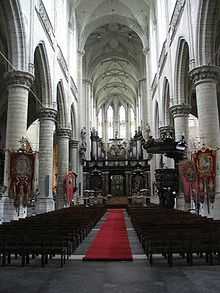St. James' Church, Antwerp

St. James' Church (Dutch: Sint-Jacobskerk) in Antwerp, Belgium, is built on the site of a hostel for pilgrims to Santiago de Compostela. The present building is the work of the Waghemakere family and Rombout Keldermans, in Brabantine Gothic style. The church contains the grave of Rubens in the eastern chapel.
History
From 1431 on, even before the church was built, the chapel on this site was a stop on the route to the burial place of Saint James the Great in Santiago de Compostela. In 1476 the chapel became a parish church so plans were made to replace the modest building with a large church. Fifteen years later, in 1491, construction of the late Gothic church started. It was not completed until 1656, when Baroque architecture was in vogue. Fortunately throughout all those years the architects closely followed the original Gothic design, hence the consistent Gothic exterior. The interior however is decorated in Baroque style.
The plans at the start of the construction, in a time when Antwerp was on its way to becoming one of the most important economic hubs in Europe, were very ambitious. The church was to feature just one tower, but this was to be about 150m tall (492 ft), well above the 123 m (403 ft) of the two planned towers of Antwerp Cathedral.
Unfortunately, due to the decline of the city from the mid 16th century on, financial problems eventually caused construction to be halted after the tower had reached just one third of its planned height.
In the 17th and 18th century St. James' Church was the parish church of Antwerp's prominent citizens, several of whom built private burial chapels in the church. The most famous is that of Antwerp's renowned painter Peter Paul Rubens, completed five years after his death in 1640. The painting above Rubens' tomb is by the master himself.
Although the original interior was destroyed during the iconoclastic storms of 1566 and 1581, the Baroque 17th century interior is well preserved thanks to a priest who pledged allegiance to the French revolutionaries, who had just invaded the city. In return, he was rewarded by being permitted to choose one church in Antwerp which would not be plundered, and chose St. James', thus saving the interior. Many of the original stained-glass windows were unfortunately destroyed during World War II.
Among the Baroque interior decorations are the carved wooden choir stalls, created between 1658 and 1570, the opulent main altar (1685) and the communion rails of the holy chapel (1695). The central pulpit was created in 1675 by Lodewijk Willemssens. The organ, built by J.B. Forceville in 1727, is also original, including the still functioning mechanical action.
External links
| Wikimedia Commons has media related to Sint-Jacobskerk, Antwerp. |
Coordinates: 51°13′12.75″N 4°24′38″E / 51.2202083°N 4.41056°E